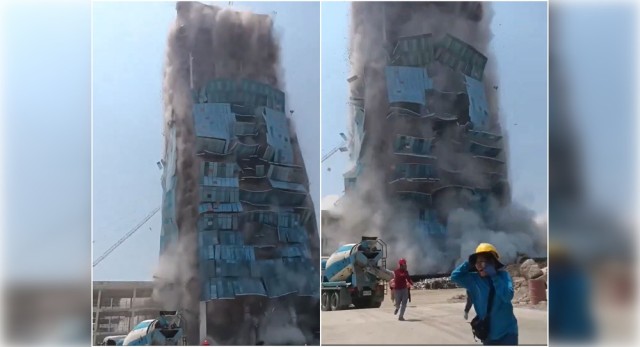
A Significant Earthquake Sends Shockwaves Throughout the Region
A powerful earthquake measuring 7.7 on the Richter scale struck central Myanmar on Friday, March 28, 2025, at approximately 1:20 p.m. local time, as reported by official geological monitoring agencies. The tremor, which originated close to the city of Monywa, was intense enough to be felt in several neighboring countries, including Vietnam, Thailand, China, Laos, and India.
The seismic event was succeeded just 10 minutes later by another significant earthquake — this time, a 6.4-magnitude aftershock — occurring roughly 20 kilometers from the town of Kyaukse, also in Myanmar.
Epicenter Information and Depth

As per India’s National Center for Seismology, the epicenter of the initial 7.7-magnitude earthquake was identified at:
Latitude: 21.93°N
Longitude: 96.07°E
Depth: 10 kilometers
Region: Near Monywa, Central Myanmar
The shallow depth of the earthquake is a crucial reason why the tremors were experienced over such an extensive area.
Widespread Tremors Across Southeast Asia
Vietnam Reports Shaking in Multiple Cities
In Vietnam, residents of Hanoi, Ho Chi Minh City, and various other urban locations reported experiencing tremors, particularly those residing in high-rise apartment complexes. Many individuals took to social media to share their experiences, describing the sensation as a swaying or rolling motion that lasted for several seconds.
Authorities have confirmed that the earthquake was indeed felt across Vietnam, although, at this moment, there have been no reports of structural damage or injuries.
Tremors Felt in Bangkok and Other Regional Capitals
In Bangkok, Thailand, the tremors were significant enough to cause water to slosh out of swimming pools — a typical indicator of medium to strong seismic activity in urban settings. Local news sources also indicated that several office employees in tall buildings experienced brief shaking in their workplaces.
Similar accounts emerged from regions in northern India, Laos, and southern China, where the ground movement, although milder, was still noticeable to residents in multi-story buildings.
No Casualties or Damage Reported So Far
As of this writing, there have been no reports of casualties or substantial infrastructure damage in Myanmar or any of the neighboring countries affected. Nevertheless, officials are actively monitoring the situation, and aftershocks remain a potential risk in the hours and days following such a significant seismic event.
Emergency Response and Preparedness

Seismological experts stress that while the quake did not result in immediate destruction, the situation is still evolving. Local authorities in Myanmar and surrounding nations have advised citizens to stay vigilant, particularly in areas susceptible to landslides or older structures that may lack earthquake resistance.
The United States Geological Survey (USGS) and local seismology institutions throughout the region are diligently tracking aftershock patterns and potential secondary hazards.
Context: Recent Seismic Activity in the Region
Southeast Asia is situated within a geologically active area where tectonic plates frequently shift, resulting in earthquakes of various magnitudes. In recent months, the region has experienced a series of smaller quakes, although none have reached the scale of today’s 7.7-magnitude event.
In February 2025, a smaller earthquake measuring 2.6 on the Richter scale was recorded in Chuong My District, located on the outskirts of Hanoi, Vietnam. While this incident was minor, it served as a crucial reminder of the importance of ongoing earthquake preparedness, even in regions not typically regarded as high-risk zones.
Understanding the Richter Scale and Earthquake Magnitude
The Richter scale, although now frequently supplanted by the moment magnitude scale (Mw) in professional reporting, continues to be widely referenced. An earthquake with a magnitude of 7.7 is classified as major, with the potential to cause significant damage if it occurs near populated areas.
For context:
2.0–2.9: Minor, often not felt
3.0–3.9: Often felt, rarely causes damage
5.0–5.9: Moderate, some damage possible
6.0–6.9: Strong, capable of significant damage
7.0 and above: Major to great, with the potential for widespread destruction

The depth of the earthquake also affects how far its effects can be felt. Generally, the shallower the earthquake, the more intense the surface shaking is likely to be.
Safety Guidelines During Earthquakes
Authorities throughout the region have reminded residents of critical safety measures to adhere to during and after an earthquake:
If indoors: Drop to the ground, take cover under sturdy furniture, and hold on until the shaking ceases.
If outdoors: Move away from buildings, streetlights, and utility wires.
After the quake: Check for gas leaks, assess structural damage, and stay informed through official updates.
Preparedness kits, evacuation plans, and knowledge of how to shut off utilities can all be lifesaving in the aftermath of a significant quake.
Conclusion: A Wake-Up Call for Regional Preparedness
The 7.7-magnitude earthquake that struck Myanmar on March 28 serves as a stark reminder of the seismic vulnerability present in Southeast Asia.